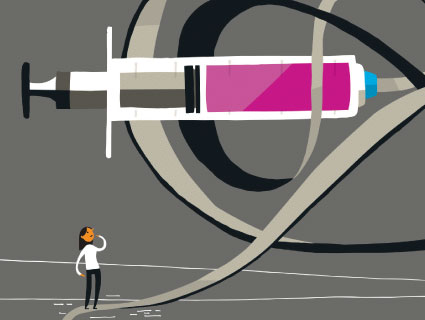The waiting room at Pediatric Alternatives in Mill Valley, a town in the affluent hippie enclave of Marin County, California, is a far cry from the drab doctors’ offices I remember from childhood. Instead of old copies of Highlights magazine and a few sticky Legos, there’s a veritable Montessori classroom’s worth of appealing toys: wholesome-looking wooden blocks, stacks of picture books, and even a ride-on Radio Flyer fire engine. For parents, there are bookshelves stocked with Moosewood cookbooks and herbal remedies and tomes about how French people get their children to eat. Black-and-white portraits of grinning kids line the walls. Even the patients and their parents look great: trim moms in yoga pants, a giggling, pigtailed preschooler playing with a sticker, an elementary-school girl holding an American Girl book. No one seems to have so much as a runny nose.
This scene isn’t the only impressive thing about Pediatric Alternatives. The practice’s five physicians have impeccable credentials, having trained and completed residencies at some of the nation’s top medical schools and institutions. Several are fellows of the American Academy of Pediatrics.
Given all this, it might surprise you to learn that one of Pediatric Alternatives’ policies is extremely unorthodox: It suggests that families delay certain childhood immunizations—in some cases for years past the age recommended by the Centers for Disease Control and Prevention—and forego others entirely. A little less than 20 percent of the families the practice treats choose not to vaccinate at all. The rest use a modified vaccine schedule.
While the American Academy of Pediatrics discourages alternative vaccine schedules, it doesn’t forbid them for its members. And the insurers that contract with Pediatric Alternatives—which include Blue Cross, Blue Shield, Aetna, and Cigna—haven’t raised any protest. As Aetna puts it, “We don’t dictate care.” The California Department of Health simply requests that “parents ensure their children are immunized according to the schedule recommended by their physician.” The state of California, meanwhile, makes it relatively easy to opt out of vaccines: Parents are not required to follow the federally recommended schedule, and those who wish to skip shots entirely need only obtain the signature of their child’s pediatrician. (Rules vary in other states. See our map.)
If these top-shelf pediatricians and the regulatory bodies that oversee them are willing to allow customized immunization plans for each patient, then is there a possibility they are onto something? Could it be that much of what we’ve heard about the importance of timely vaccines is wrong?
While it’s almost unheard of for a pediatrics practice to make alternative vaccine schedules part of its official policy, skipping immunizations is far from unusual among parents in Marin County. Kindergartners here have one of the nation’s lowest vaccination rates, so it’s probably no coincidence that the county also has the second-highest rate of pertussis (whooping cough) in California.
On a recent Wednesday, Stacia Kenet Lansman, the founder and lead physician of Pediatric Alternatives, greets me warmly. A veteran pediatrician with 20 years of experience, she has a slight frame, shoulder-length gray hair, and a kind of favorite-aunt vibe about her. Her manner is friendly and she smiles often. It’s easy to picture her comforting a sick child.
Seated across from me in her exam room, Kenet Lansman sums up her professional trajectory: After attending the Tufts University School of Medicine, she took a pediatrics residency at Children’s Hospital Oakland. In 1996, she moved to Marin and began seeing patients in a local pediatrics office. It didn’t take her long to notice a disconnect between her schooling and her practice: During her residency, she treated sick children, but the kids she saw in Marin were, for the most part, healthy. Her job, she decided, was to keep them that way. She began to study alternative medicine and was influenced by the work of Deepak Chopra and Andrew Weil.
In 1998, she founded Pediatric Alternatives, with the goal of combining Western medicine with nontraditional methods like homeopathy, herbalism, and dietary treatments. This approach, she hoped, would “start children and families out with healthy habits and routines so that they are more likely to stay healthy.” The practice flourished. Today, she and four other physicians at Pediatric Alternatives treat somewhere between 1,500 and 2,000 patients from around the Bay Area.
Kenet Lansman tells me she would never deny any vaccine to parents who request it for their child. But she does share her personal beliefs with her patients: She fears that vaccines have contributed to the recent uptick in autoimmune disorders and other chronic conditions. “I think we’re just messing with nature, and we really don’t know what we’ve created,” she says. “We’ve reduced or largely eliminated many infectious diseases. But in their place, we have an epidemic of chronic illnesses in children. The incidence of asthma, allergies, and autism spectrum disorders has dramatically increased since the 1990s. And the reason for this we don’t know. But my concern is that vaccines have played a role.”
She has a policy of giving only one vaccination at a time, and only when a child is completely healthy. “I believe that the detoxification pathways in the body can be overwhelmed by too many vaccines given on one day,” she explains.
Pediatric Alternatives prioritizes childhood vaccines based on the perceived risk of a kid acquiring a given disease. “We live in a very healthy community,” Kenet Lansman says. “The incidence of these illnesses are very low, not only here, but nationwide. And so it’s safe to do a modified vaccine schedule, in my opinion.”
She does adhere to the federal schedule for certain shots: She encourages parents to get their children the DTaP shot—which protects against pertussis, diphtheria, and tetanus—during the child’s first year. She also recommends that babies get vaccinated for meningitis—which is dangerous and very contagious—when they are a few months old.
On the other end of the spectrum are diseases Kenet Lansman considers extremely low-risk for babies. For instance, she reasons that her patients have virtually no chance of catching hepatitis B, which is generally only transmitted through sex and intravenous drug use, “not something babies are commonly engaging in”—she advises parents to forego that vaccine altogether. She also suggests skipping the varicella (chicken pox) and rotavirus vaccines, because those diseases are not life-threatening for the vast majority of children. While she doesn’t list the polio vaccine among the shots she believes patients should skip, she tells parents that the risk of children contracting polio in the United States these days is essentially nonexistent.
And then there are diseases that fall into a grayer area: The risk is not high, but it’s not zero, either. For these, Kenet Lansman recommends a delayed schedule. Because the incidences of measles, mumps, and rubella in the Bay Area are very low, she suggests that parents put off the MMR vaccine for their kids, unless they are traveling to a place where these diseases are endemic. The federal guidelines recommend MMR at age one; Pediatric Alternatives typically waits until age three to administer the shot.
The main reason for the delay, Kenet Lansman says, is that she still believes there could be a link between vaccines and autism. She acknowledges that the scientific community has rejected this theory, yet she says she has seen children from her own practice who begin to show signs of autism shortly after being vaccinated. “My feeling is that if there is any risk that the vaccine is associated with autism, we should delay the vaccine during this vulnerable developmental window,” she says.
Several times during my visit, Kenet Lansman mentions that in her 16 years of offering alternative vaccination schedules, not one of her patients has come down with a vaccine-preventable disease. What’s more, she adds, she has noticed that patients in her practice actually seem healthier than most of their peers. “Our office tends to be quiet during flu season,” she says.
I have to admit she has a point. Where the risk of catching measles or mumps is practically zero, if there’s any possibility at all that vaccines could contribute to chronic health problems, then why not use them judiciously?
For a reality check, I call up some outside experts, including Alanna Levine, a pediatrician in Orangeburg, New York, and a spokeswoman for the American Academy of Pediatrics, to ask what they thought of this boutique approach to immunizations. “My blood is boiling right now,” Levine replies. “I think that policy is dangerous. I think it puts children at risk when they are most vulnerable.”
Saad Omer, a professor of public health and vaccine expert at Emory University, holds a similar view. “There is a reason why we give vaccines to young children,” he says. “That’s because the risk of disease is higher for certain age groups. You want to give vaccines as early as possible to protect the child. If you delay, you are leaving the most vulnerable period for the child open.”
While Omer declined to comment on Pediatric Alternatives specifically, he points out that the group that comes up with the official vaccination recommendations is interdisciplinary; the resulting schedule reflects the perspectives of epidemiologists, microbiologists, policy experts, and others, in addition to pediatricians. “There is a reason why the advisory committees make schedules—not an individual,” he tells me.
Omer adds that he considers it very risky to vaccinate only against diseases that are prevalent in a particular community. “Most practices don’t have a community surveillance system,” he says. “They don’t know whom these kids interact with or where they will travel. Infectious diseases are by nature infectious, so it’s not just individual behavior that matters. It’s everyone’s vaccinations.”
The concept that a critical mass of vaccinated people shields the rest is known as “herd immunity.” Within every community, there are people—mostly infants under one year of age and people with compromised immune systems—who can’t tolerate vaccines. And there are others whose vaccines may have worn off, or for whom a particular vaccine never elicited a strong immune response. The pertussis vaccine, for example, has a relatively low rate of effectiveness: It confers immunity on just 80 percent of people who receive it. “Anyone could end up not being protected,” Omer says. “So their protection depends on other people’s behavior.”
Paul Offit, a vaccine expert and chief of infectious diseases at the Children’s Hospital of Philadelphia, tells me he often encounters parents who are afraid that too many vaccines will overwhelm their child’s immune systems. But the contents of the vaccine, he says, are nothing compared to all the germs one encounters daily. “The shots are a drop in the ocean of what your body does every single day,” he says. “It looks bad, because the kid is stressed out, but it is certainly not actually bad.”
Still, I wonder, how much can an individual pediatrics office matter? Even if Pediatric Alternatives’ vaccine practices aren’t ideal, would a few thousand unvaccinated toddlers in California really bring about an epidemic? Maybe not, says Omer. But if the alternative-schedule trend catches on, we could be in trouble. Beyond the skipped vaccines, the one-shot-per-visit policy means more visits to the doctor, “so the parents have to take more time off to bring the child to get the vaccines,” he adds. That creates more chances for missed appointments—which means more undervaccinated children.
Pediatric Alternatives is hardly the only practice offering modified vaccine schedules. Dr. Robert Sears popularized the practice with his 2007 book, The Vaccine Book: Making the Right Decision for your Child. A quick search of the Berkeley Parents Network, a local community forum, turned up recommendations for a handful of Bay Area pediatricians who don’t insist that their patients stick to the official schedule. A 2012 study in the journal Pediatrics found that the percentage of children in greater Portland, Oregon, receiving two or fewer immunizations per doctor visit tripled between 2006 and 2009, leading the authors to conclude that Portland parents had increasingly chosen to delay their children’s vaccines. A 2011 University of Michigan survey found that nationwide, 13 percent of parents use an alternative immunization schedule.
Not all pediatricians who offer delayed vaccines do so out of concerns about the shots’ safety. Some simply see the alternative schedules as a compromise. Janet Perlman, a pediatrician with offices in Oakland and Berkeley, figures late immunizations are better than no immunizations. “I will do anything to get the vaccines in,” she tells me. “I just want to get the kids vaccinated.”
But Levine, the New York pediatrician I spoke with, has a different approach: If parents won’t stick to the schedule, she just won’t treat their children. In the 11 years she has practiced, she’s had to convince many hesitant parents that vaccines are safe. “It’s a long conversation,” she says. “It takes time. But it is worth it, because most of the time, if you really listen to what their concerns are and address them, they end up vaccinating on time.”
At the end of my visit to Pediatric Alternatives, I found that I liked Dr. Kenet Lansman. I could tell that she was bright and caring and open-minded, and most impressively, she tried to think creatively about how to keep her patients healthy. She’s right that there is an epidemic of chronic autoimmune illnesses and autism among children, and a mounting body of research suggests that our aggressive pursuit of germs—both in our environment and in the human body—might have something to do with it: When we kill disease-causing germs, the theory goes, we kill beneficial bacteria, as well, making our bodies’ defense systems go haywire.
But there is no research supporting the notion that vaccines contribute to autoimmune disorders or autism—and plenty of evidence showing that diseases like measles can be deadly. By deviating from the scientifically proven vaccine schedule, Kenet Lansman is playing a dangerous game. No matter what she believes about children in her practice being exceptionally healthy, the threat of catastrophic infectious diseases is real—and outbreaks are very hard to predict.
So far this year, there have been confirmed clusters of measles in the United States—36 cases in California and 20 in New York City. The unvaccinated patients of Pediatric Alternatives don’t live in a bubble. People travel. Consider this scenario: A patient of Kenet Lansman catches measles from a visitor from a part of the world where measles is still endemic. He then spreads it to his neighbor’s newborn, who isn’t old enough to be immunized, or to the kid at school whose immune system is weak because she is going through chemo.
This scenario isn’t far-fetched. During the 2010 pertussis outbreak, 10 babies in California died of the disease.
I was glad to hear that none of Kenet Lansman’s patients have contracted vaccine-preventable diseases yet. I just hope her luck does not run out.












